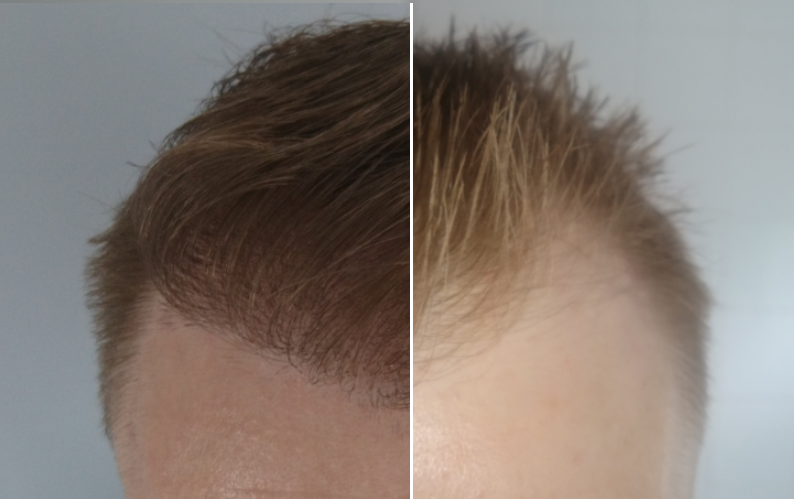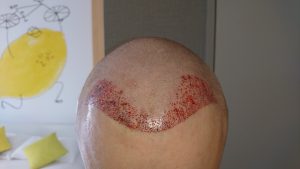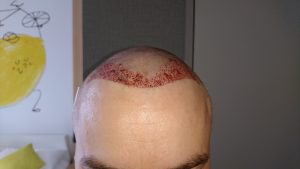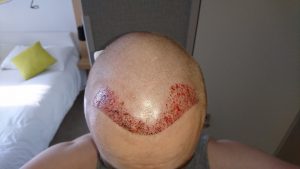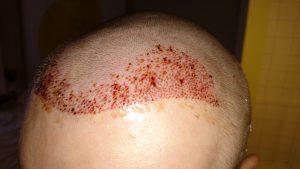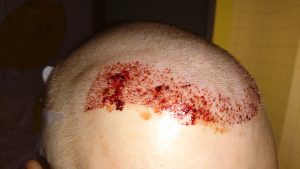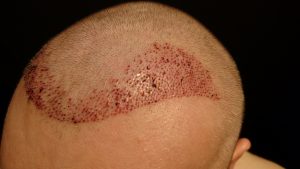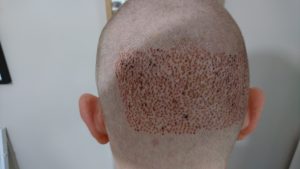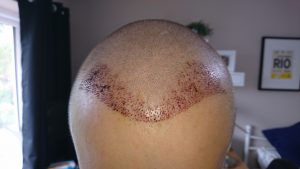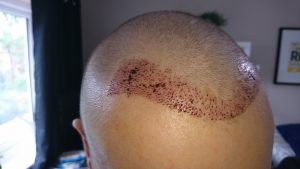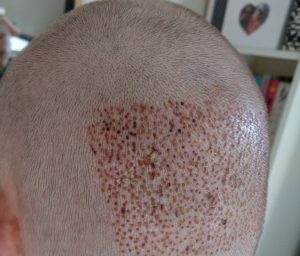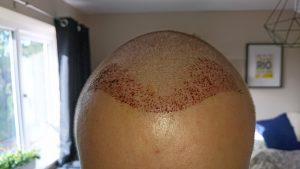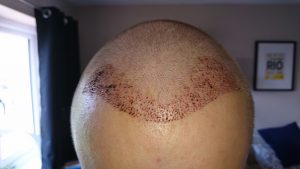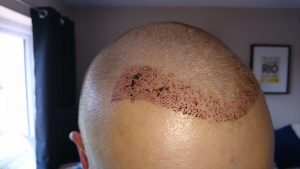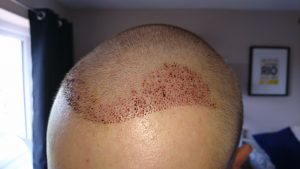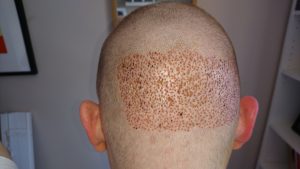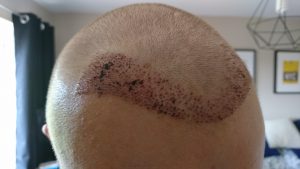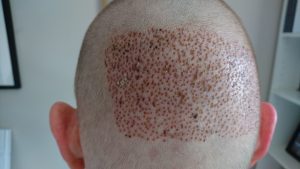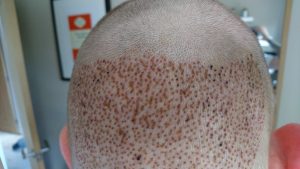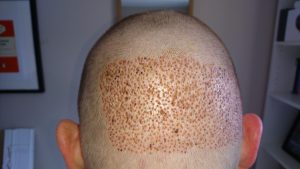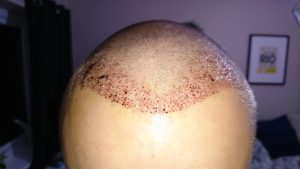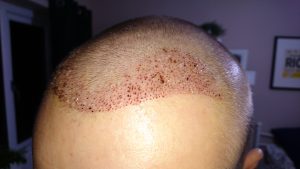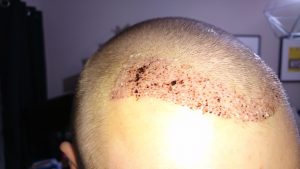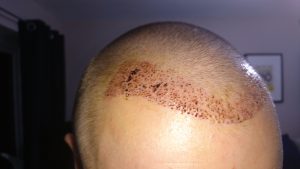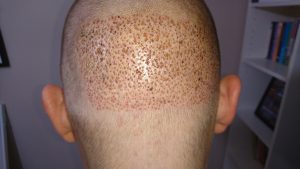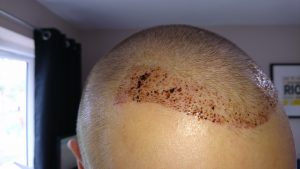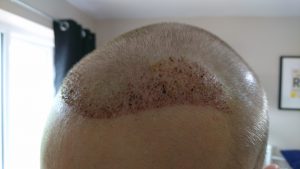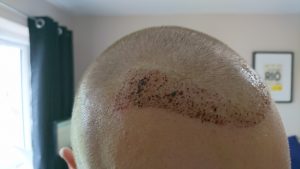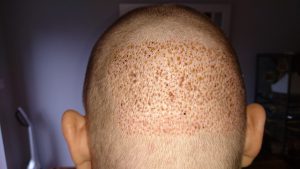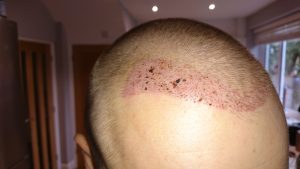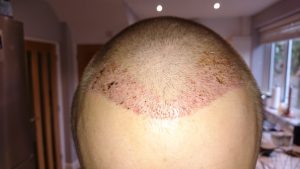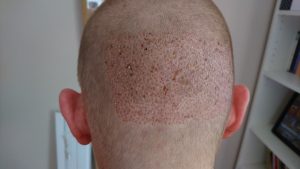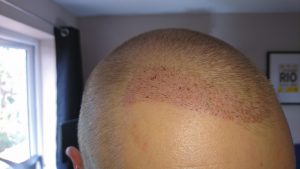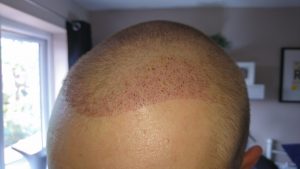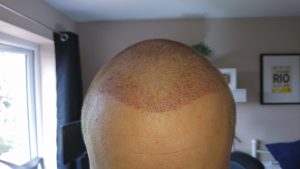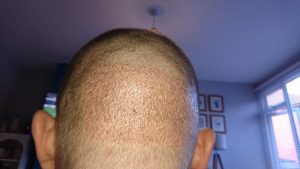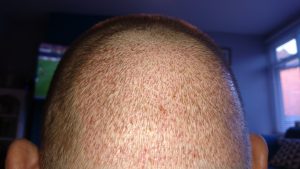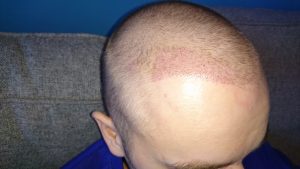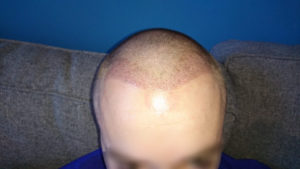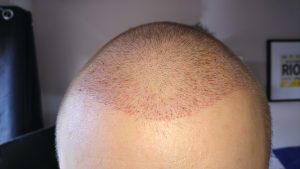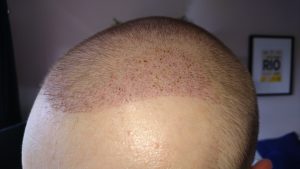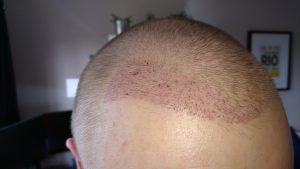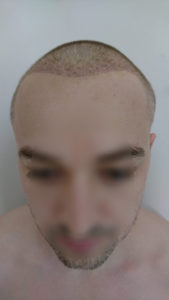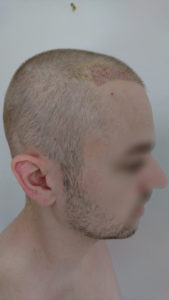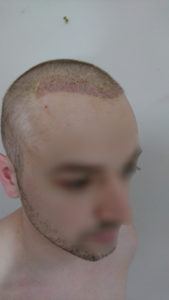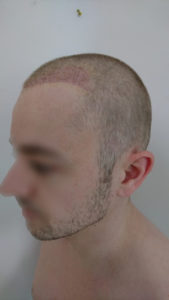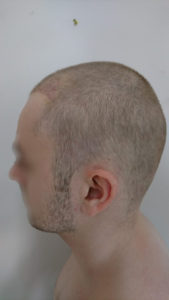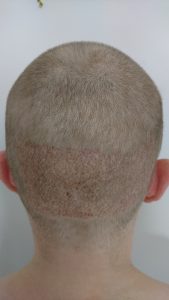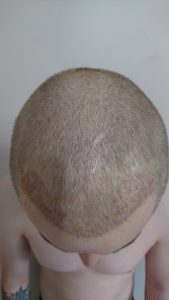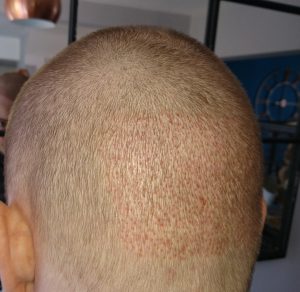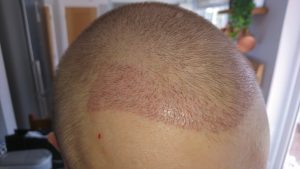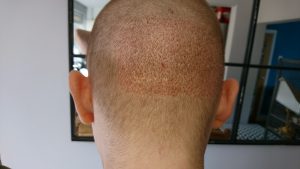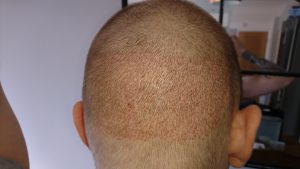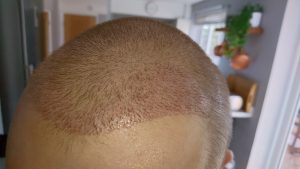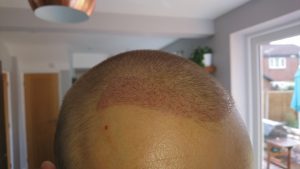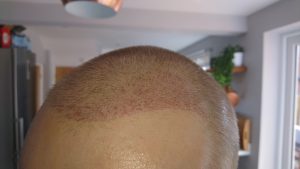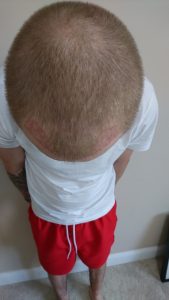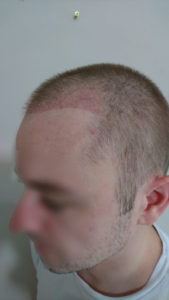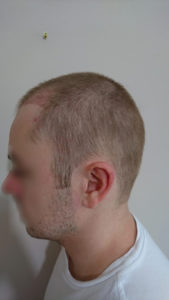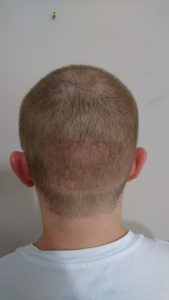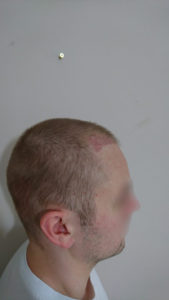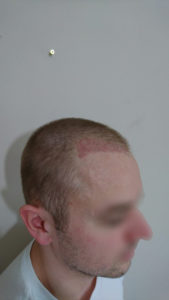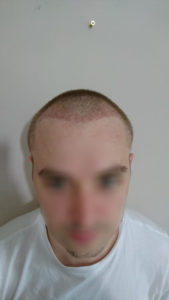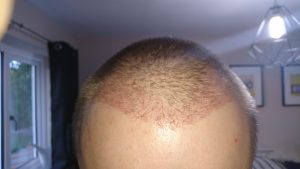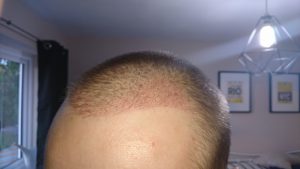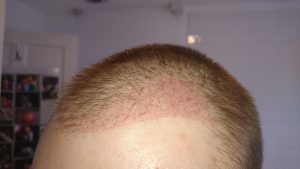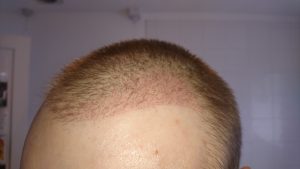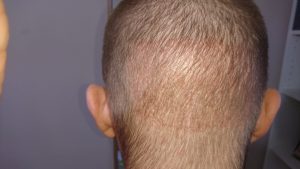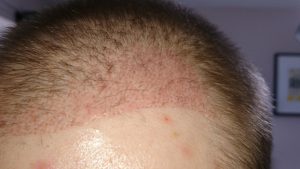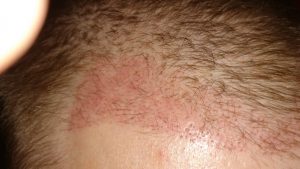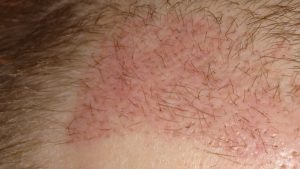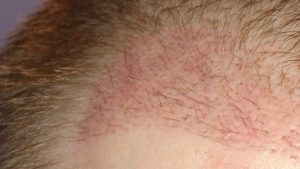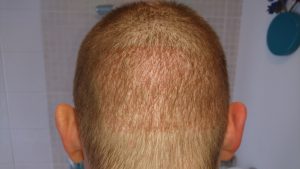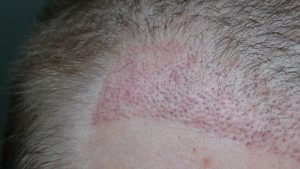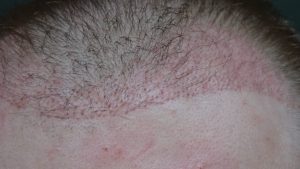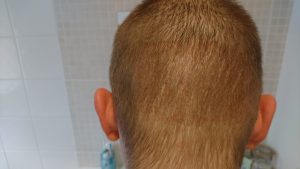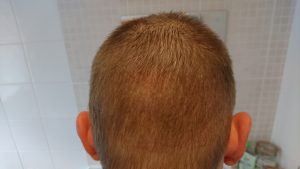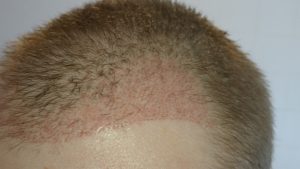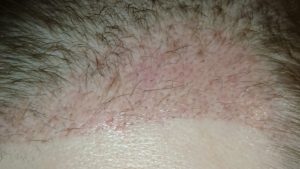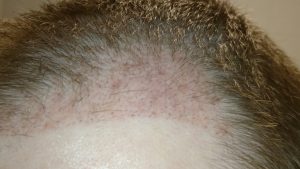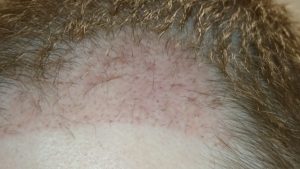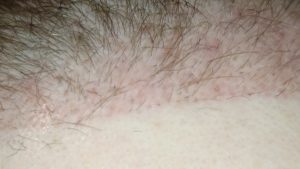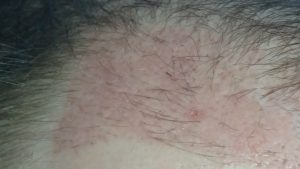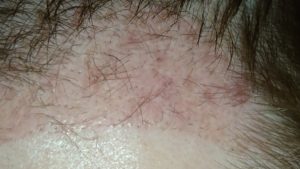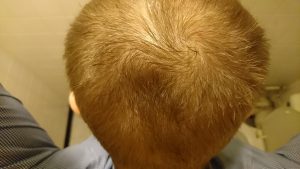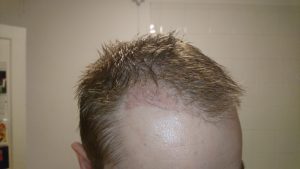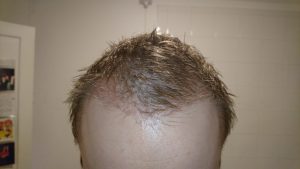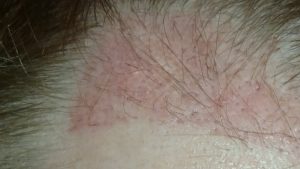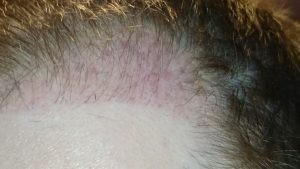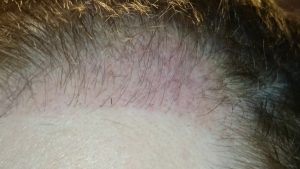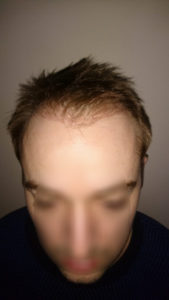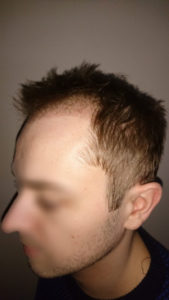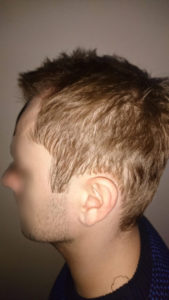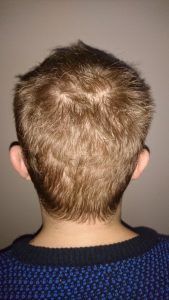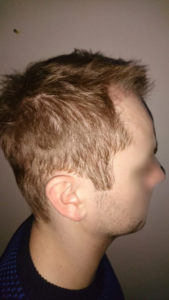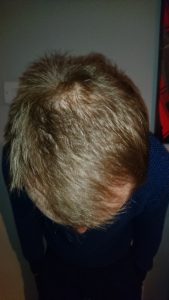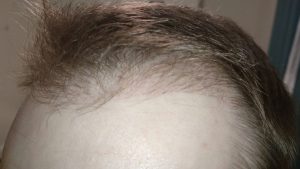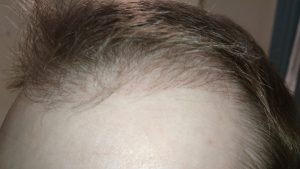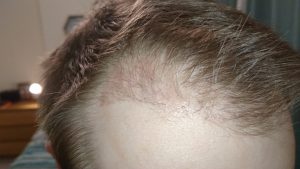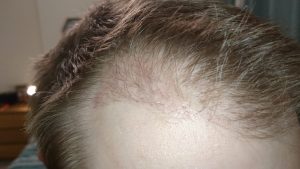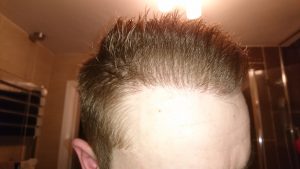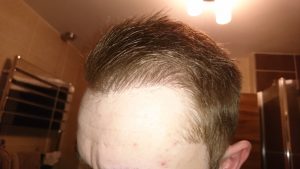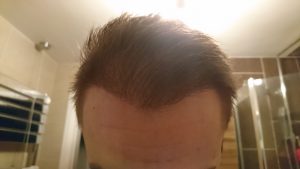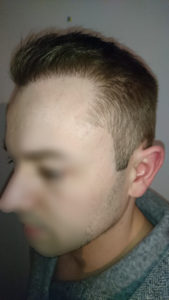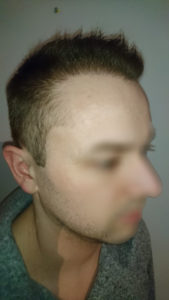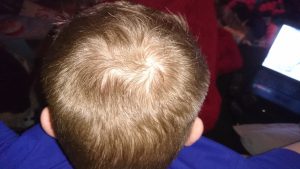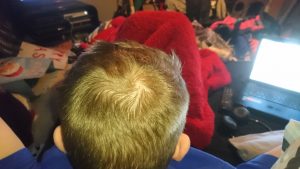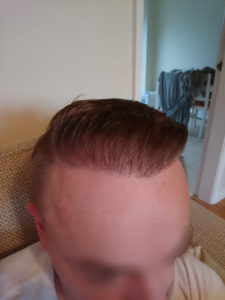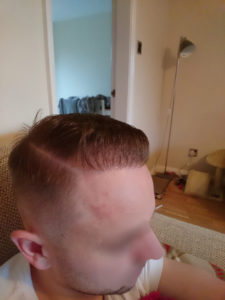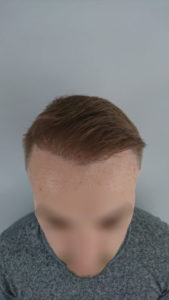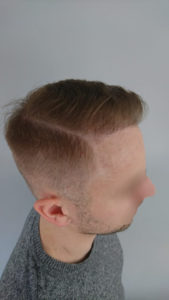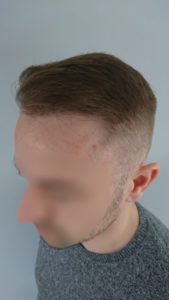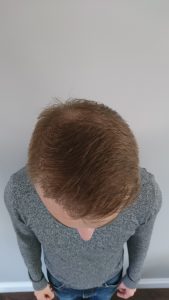Hi, I’m John and in my early 30’s I had an FUE Hair Transplant to restore my hairline at the front.
Below is a detailed breakdown of my post-op recovery from day 1 all the way up to 12 months post-op. I’m now in my late 30’s, my transplant was over 3 years ago.
We also look at the present day and what else I’ve experienced over the last 3 years.
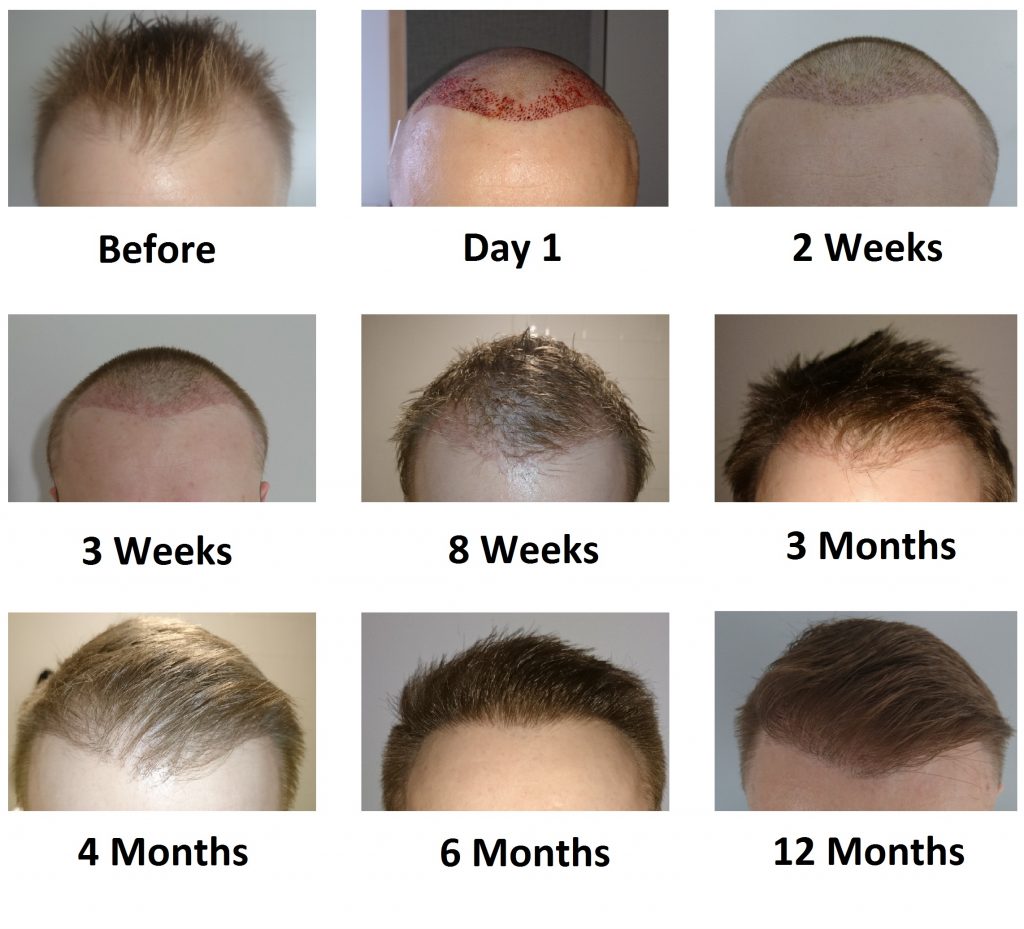
FUE Post-Op Day 1 – Immediately After Surgery
Immediately after my hair transplant, it looked a lot worse than it felt. I was quite bloody and a little tired but otherwise I felt great. I think that was because I knew it was done and that soon I’d have hair!
I’m from the UK and I chose to fly to Budapest for my hair transplant, which is about 2 and half hours flight from my home. I got to Budapest the night before my transplant, checked in, ate and got an early night.
I woke up the next morning and walked a few yards to the clinic at 9 am. The accommodation was provided by the clinic. After going through some formalities I was prepped for surgery and in the theatre.
Fortunately, researchers in Norway succeeded in stopping hair loss and promoting regrowth in 63.9% of test participants by using fish proteins!
Although not flawless … fish proteins, minerals, and antioxidants have a positive effect on strengthening hair.
Transplant Procedure
The morning consisted of a few painkiller injections in my scalp – the first one or two I felt, but the rest were fine. I then lay face down on a table similar to a massage table whilst the doctor extracted grafts from the back of my head.
This part didn’t hurt, I actually fell asleep.
I woke up around midday and we had a break for lunch, which was also provided by the clinic – at the start of the day they gave me some local menu’s so the choice was good.
In the afternoon I went back into the theatre. This is the fun part. The doctor drew a hairline on my head and discussed what could be achieved.
After a few small tweaks, I then chose a film from a huge catalogue the clinic had. I then sat upright in a supported chair similar to a dentists chair and watched the film I chose whilst the doctor and technicians implanted the hairs they had extracted.
It was all done, bandaged up and back at the hotel by 3.30 pm. The clinic had given me a care pack that contained aftercare documents, painkillers, antibiotics, saline solution and pads to rest my head on – a week’s supply. After inspecting my care pack I pretty much crashed.
NOTE: It takes 7 days for newly transplanted hair follicles to properly graft to your scalp. So the aftercare in the first week is crucial!
Transplant Aftercare
For the first week, you will need to spray your scalp every hour until the saline solution given to you runs out. The saline solution helps clean and disinfect your scalp. You also take antibiotics twice a day to prevent infection.
You are given painkillers to take when required, which for me was only a couple of times during the first 2 or 3 days. You can shower and bathe during the first week, but you cannot put your head under the water or directly under the shower.
You also have to sleep with your upper body upright at a 45-degree angle (closer to 90 degrees for larger procedures). The key thing is to relax and not overexert yourself in the first few weeks. I took time off work and didn’t really leave the house for the first 2 weeks.
As well as the above aftercare I also took sleeping pills on a couple of occasions in the first few days. This wasn’t due to any pain. It was more because the travel had disrupted my sleeping pattern. And because sleeping with my upper body upright was a strange thing to adjust to.
In your aftercare pack, you are given pads to rest your head when sleeping. I suggest using these for the first 2 or 3 nights as your wounds will weep a little, especially on the first night. If you don’t you’ll need new pillowcases!
FUE Post-Op Day 2
I slept really well on the first post-op night. I didn’t have any pain on the day of the surgery, but I did have a little pain on day 2. So I took a couple of painkillers and felt fine.
Day 2 was fly home day.
Some clinics give you a travel cap to wear on your return journey. I advise asking your clinic if they offer this, and if not buying one yourself. I forgot to ask and had to re-bandage the back of my head as it was still very red and a little bloody.
Scabbing was already forming, but I didn’t feel confident travelling with the back of my head exposed. So with care to not cover my newly transplanted hair on the hairline I have covered the back just for the journey home.
I could see progress on day 2. My hairline was quite red, more so than the average person apparently, and scabbing was forming nicely. The saline solution definitely helped with that, so I decided to continue applying it as much as possible. Again it looked bad but felt fine. I had a little soreness, mostly in the back of my head where the grafts were taken from.
The clinic advised that I may see swelling appear on my forehead as a result of the injections into my scalp on the day of surgery. The injections numb the pain and make your scalp more malleable, but do leave a little fluid build-up.
I saw a little swelling at the top of my forehead on day 2. Other than that I felt good and I couldn’t wait to get home. You can massage your head to distribute the fluid build-up, but I waited until day 3 for that.
FUE Post-Op Day 3
On post-op day 3 the redness had reduced a little bit and more scabbing had formed. The pad I slept on the night before was pretty much clean this morning, so it’s looking like you only need to sleep on a pad or old pillowcase for the first couple of days until scabbing has formed in your donor area at the back.
The swelling on my forehead started to move down. It moved down from the hairline to the middle of my forehead. I started to massage it as advised, putting my fingers in the middle of my forehead and lightly moving them outwards towards my temples. I did this 2 or 3 times on day 3.
I also noticed a tight feeling on the back of my head where the grafts were taken from. As the skin was starting to heal and the swelling was reducing the back of my head started to feel hard and tight. It didn’t cause too much discomfort. It was more something that you are aware of rather than something that caused pain.
FUE Post-Op Day 4
I woke on day 4 and the swelling had moved down towards my eyebrows. But I slept at an angle so it was now not even – one eye was a little closed. It felt fine, it just looked a little funny. Looking back I jumped the gun and relaxed my sleeping position a day too early.
In retrospect, I should have been using a travel pillow and ensuring my upper body was elevated at a 45-degree angle with my head looking straight forward.
At this point, I hadn’t taken any painkillers or sleeping pills for the last night or two and I felt good. The redness had reduced further and some of the scabbing was starting to fall off naturally by itself.
Everything was progressing exactly as the clinic had advised. But at this point, I hadn’t had a proper shower for a few days, which was a little frustrating.
I had been showering at a moderate temperature without wetting my head since the surgery. You can’t have a proper shower or bath for 7 days, as mentioned above your grafts need 7 days to fully attach.
FUE Post-Op Days 5 – 7
Day 5
Day 6
Day 7
Between days 4 and 7, my swelling and redness had reduced, any fluid build-up on my forehead dispersed and a lot of my scabbing had come off naturally.
I noticed a small amount of discolouration around my forehead, the type you would expect after bruising. Everything was progressing nicely though.
You are encouraged to have a shower at the week mark so that any of the remaining scabbing comes off. A lot had already come off naturally, most of the remaining scabbing came off in the shower. I made sure not to overdo it with my first shower. I had it set to a moderate temperature, I wasn’t in there too long and I gently dabbed my head dry afterwards.
Strangely I noticed that the newly transplanted hair had started to grow at a similar rate to the rest of my hair. So aside from some redness, I had a full head of hair.
You can fool yourself into thinking that your newly transplanted hair will all stay in and just start growing. But that isn’t the case. The shock of the transplant will make the new hair fall out and the hair growth cycle starts over. It’s like hitting the reset button on your new hair basically.
FUE Post-Op Days 8 – 11
Day 8
Day 9
Day 10
Day 11
FUE Post-Op Week 2 – First Clinic Check-In
At 2 weeks you have your first post-op check-in with the clinic. As part of the post-op care, you have to send pictures at 2 weeks, 3 weeks, 3 months, 6 months and 12 months.
The feedback I got was that everything was progressing as expected. I was experiencing some lingering redness, a little more than the average person, but nothing alarming.
To help with the redness I had been applying aloe vera gel to the back of my head and hairline. This helped with any irritation and it reduced the redness. You have to be careful not to apply too much as it can dry into a thin hard layer and can cause a little irritation. Small amounts frequently work well.
At week 2 some of the new hair started to fall out as expected. The newly transplanted hair follicles basically have the reset button hit on them. The hairs drop out but the follicles remain intact.
The follicles then go into a short resting phase before going back into the growing phase. This is called the ugly duckling period. This lasts for around 3 to 4 months on average, but everyone is different.
It gets worse before it gets better, but this is what I expected from my research and from the advice of the clinic.
Fortunately, researchers in Norway succeeded in stopping hair loss and promoting regrowth in 63.9% of test participants by using fish proteins!
Although not flawless … fish proteins, minerals, and antioxidants have a positive effect on strengthening hair.
FUE Post-Op Week 3 – Second Clinic Check-In
Second check-in with the clinic time! I took pictures and sent them in by email. I would say at 3 weeks about 80% of the transplanted hair in my hairline had fallen out.
The redness I had at the front and at the back of my head had reduced quite a bit but was still visible. The clinic informed me that everything was looking good at this point.
Apparently, at this point, the redness should have subsided more, so it looks worse for me than it would for the average person. So my skin appears to be a little more sensitive than most people, and being pale didn’t help me. I continued with the aloe vera gel and was happy with my progress at 3 weeks post-op.
I would say at 3 weeks you are quite confident rubbing your hair in the shower, engaging in more strenuous exercise, and generally getting out and about.
At first, I was paranoid that I would accidentally pull out some of the new hairs. But at this point, I was quite confident. At 3 weeks post-op, your aftercare is over, it’s all about waiting and patience.
FUE Post-Op Weeks 3 – 6
Week 3
Week 4
Week 5
Between 3 and 6 weeks post-op, not that much happens to tell you the truth. About 80% of the newly transplanted hair had fallen out and I was just waiting for it to grow back. I was hoping to see a little growth but progress is slow this early on.
The redness on my hairline reduced quite a bit by week 6. It was still visible but I would say that you just look a little sun-burnt at the front. At the back of you couldn’t see anything anymore.
FUE Post-Op Weeks 6 – 8
Week 6
Week 7
Weeks 6 to 8 were very much like weeks 4 to 6, not much movement to report. I would say my key observation during this time is that you can feel negative about the procedure.
You’ve paid money and come so far, but if anything you look worse. This is the hard part. You have to be patient and be mentally strong. The hair starts growing very soon!
FUE Post-Op Weeks 8 – 12
I won’t lie these weeks are hard. At 3 weeks post-op, most of your newly transplanted hair falls out, about 80% in my case. From weeks 4 to 12 you are waiting for progress and it’s really slow going.
That said as the weeks progressed I became a little bit more relaxed about the situation and I stopped looking in the mirror so often. At this point, you are just waiting to get through the next few weeks.
FUE Post-Op 3 Months – Third Clinic Check-In
I submitted my post-op month 3 pictures to the clinic by email and the feedback was good. There are pretty much no signs of surgery at this point, but you are still waiting for your new hair to grow.
The average person has to wait until around month 4 or 5 to see hair starting to grow back. The hair you had before will start to grow, so your donor area at the back will look normal, but your transplant area at the front or on top won’t look amazing.
Because your hair is growing at the back and sides you will have to trim it. Some people buy clippers and cut them themselves. I went to the hairdressers and asked them to trim the sides but leave the top. It’s hard getting through this 10-14 week period, but it’s worth it and it gets easier as the weeks go by.
FUE Post-Op 4 Months – I’ve Got Hair!
I’ve got hair!!!! Having seen very little movement for 3 months all of the sudden progress really picked up. I went from having about 20% coverage at my hairline to having about 60% thickness.
You could actually see my new hairline. Your hair at this point looks thin, but there are no signs of having had a transplant.
It is hard waiting between the 1 month and 4 months, but overnight it becomes well worth the wait! At this point, I went for my first proper hair cut and I actually got to choose a hairstyle!
And it is one that I wanted, rather than having to settle for something that disguised my receding hair. The difference a few weeks made was truly amazing!
FUE Post-Op 5 Months
At 5 months post-op, I would say that my hairline reached about 80-90% thickness. I started going to the hairdressers every month for a trim, or a new hairstyle.
I really enjoyed that a lot. My confidence at this point was in a really good place and there were absolutely no signs of having had surgery – in fact, you wouldn’t even know I’d lost any hair in the first place.
A friend asked at this point if the new hair grows at the same rate as the rest of your hair. The answer I found was yes. It’s still your hair, after all, it’s just been moved. So yes it all grows at the same rate.
FUE Post-Op 6 Months – Fourth Clinic Check-In
At 6 months it’s time for your 4th post-op check-in with the clinic. I would say at this stage I was roughly close to 100% coverage at my hairline.
I also started to get my hair cut very short at the back and sides – a skin fade from grade 0. You cannot see any scarring at all.
The transformation between month 4 and month 6 was incredible. I actually started to forget what it was like to not have hair. And it wasn’t just me. Friends and family members also seemed to forget. It really was like my hair loss hadn’t actually happened.
FUE Post-Op 9 Months
9 Months
10 Months
I spent 6 years obsessing over my hair from my late 20’s into my early 30’s. I thought about it all of the time. It really got me down and lead to some depression if I’m honest.
But all that evaporated between 6 and 9 months post-op. I felt good at first because I took action. The first few months were hard waiting for my hair to grow. Months 4 and 5 were great because you finally see progress. But months 6 to 9 were immense.
Not only was I looking good, but my confidence was also through the roof. And all those negative thoughts seemed so far in the past I couldn’t even remember what they felt like. It was like that person didn’t exist anymore.
When I started to look into having a hair transplant I was concerned that I might spend a lot of money, and that perhaps this money could go to better use. Firstly looking abroad will reduce that spending significantly – I chose Budapest.
Secondly, since having the transplant I haven’t given the money a second thought. Having seen the results I would pay that money ten times over. It can seem like a lot, but it really isn’t. For how good I feel and how confident I am again, it now seems like great value for money.
Fortunately, researchers in Norway succeeded in stopping hair loss and promoting regrowth in 63.9% of test participants by using fish proteins!
Although not flawless … fish proteins, minerals, and antioxidants have a positive effect on strengthening hair.
FUE Post-Op 12 Months – Final Clinic Check-In
At 12 months post-op, you submit your last set of pictures to the clinic and get the final sign-off from them. If you have any concerns now is the point to arrange a follow-up treatment if needed.
The clinic I went to offered a guarantee. If I didn’t achieve at least 90 – 95% coverage and regrowth in the transplanted area I could go back for a free follow up treatment. But as you can see this was not required. Just take a look at the results…
If you have experienced some form of hair loss and a hair transplant is an option for you, I would absolutely look at doing it. The first few days are sore and require you to keep on top of your aftercare instructions.
Between 4 and 16 weeks you don’t look your best. But from around 16 weeks you start looking and feeling great. By 6 months you can’t tell that you ever had an issue in the first place.
Obviously, results differ slightly for everyone, but this is the average timeline for most.

